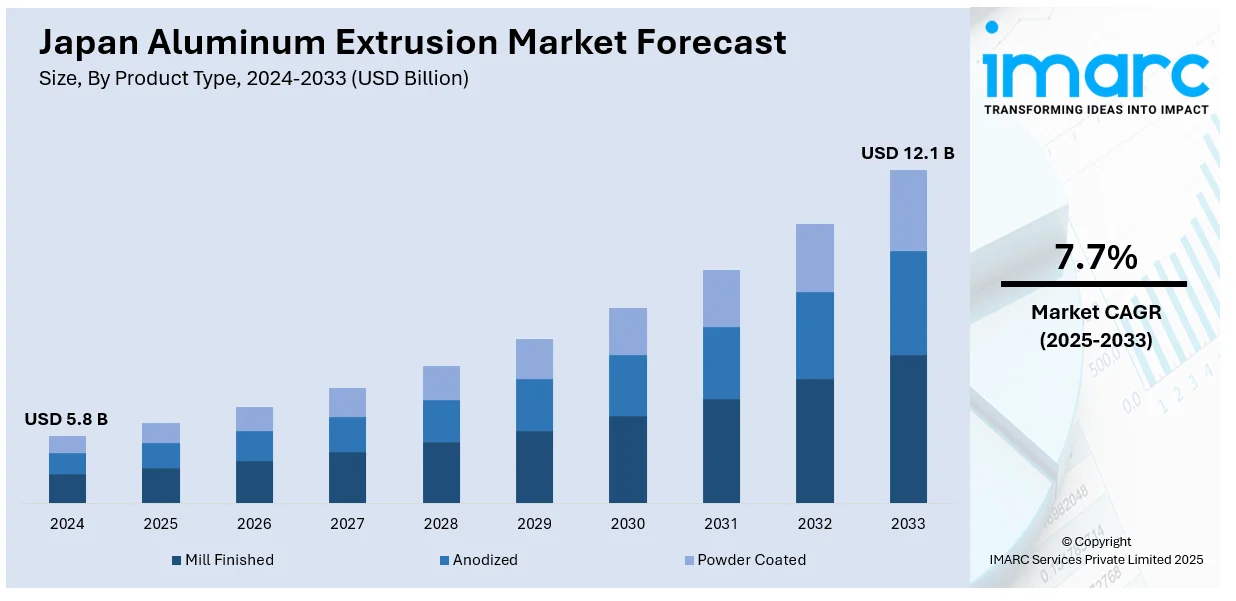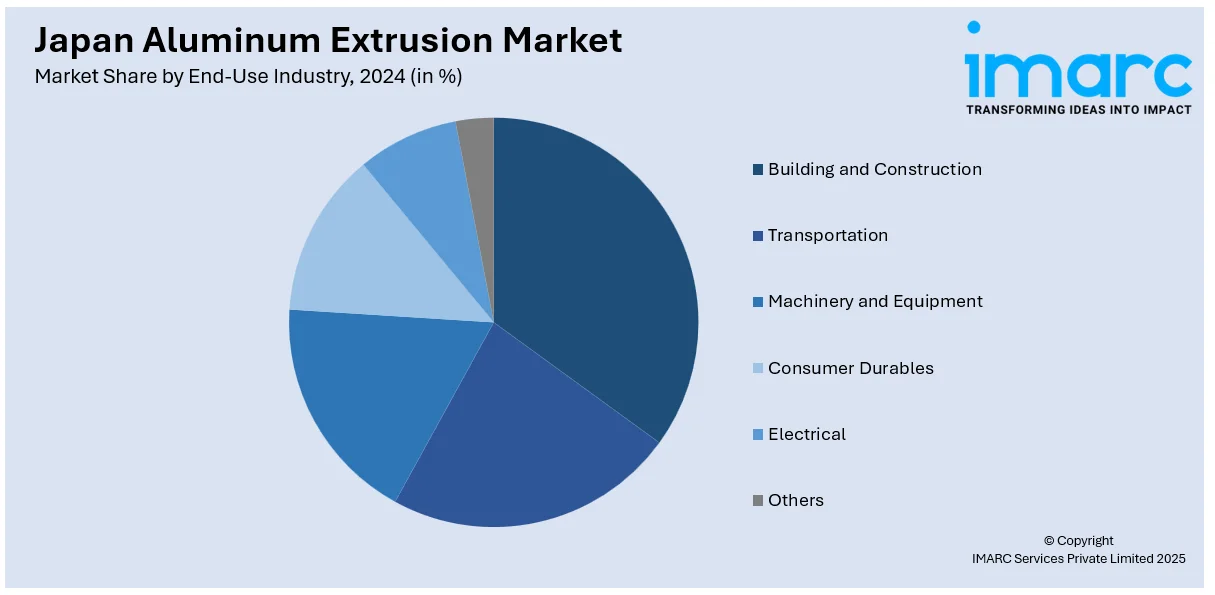
Japan Aluminum Extrusion Market Size, Share, Trends and Forecast by Product Type, Alloy Type, End-Use Industry, and Region, 2025-2033
Japan Aluminum Extrusion Market Overview:
The Japan aluminum extrusion market size reached USD 5.8 Billion in 2024. Looking forward, IMARC Group expects the market to reach USD 12.1 Billion by 2033, exhibiting a growth rate (CAGR) of 7.7% during 2025-2033. Rising demand in transport, construction, and industrial sectors, surging need for automotive lightweighting, electric vehicle (EV) growth, strict emission norms, rail infrastructure expansion, urban redevelopment, expanding electronics manufacturing, energy-efficient buildings, and focus on recyclability are factors propelling the market growth.
|
Report Attribute
|
Key Statistics
|
|---|---|
|
Base Year
|
2024 |
|
Forecast Years
|
2025-2033
|
|
Historical Years
|
2019-2024
|
| Market Size in 2024 | USD 5.8 Billion |
| Market Forecast in 2033 | USD 12.1 Billion |
| Market Growth Rate 2025-2033 | 7.7% |
Japan Aluminum Extrusion Market Trends:
Automotive Lightweighting and EV Penetration
The automotive industry’s shift toward lightweight vehicle architecture is significantly accelerating the product demand, which represents one of the key factors boosting the Japan aluminum extrusion market share. With growing adoption of electric vehicles (EVs) and hybrid models, manufacturers are increasingly substituting conventional steel parts with aluminum components to improve energy efficiency and vehicle range. Extruded aluminum profiles are particularly favored for chassis, battery enclosures, crash management systems, and structural reinforcements due to their high strength-to-weight ratio, corrosion resistance, and ease of fabrication. Leading original equipment manufacturer (OEMs) and component suppliers are investing in research to develop complex, multi-chamber extrusions for enhanced performance and crashworthiness. Additionally, the localization of EV production by global players in Japan is expected to sustain long-term demand for precision-extruded aluminum parts across body-in-white and modular assemblies.

Emission Regulations and Material Substitution
Stringent environmental regulations imposed by the Japanese government to curb carbon emissions are driving a material transition across multiple industrial sectors, including automotive, construction, and manufacturing. In 2025, Japan has adopted an updated decarbonization plan aiming to reduce greenhouse gas emissions by over 70% from 2013 levels by 2040. The strategy includes increasing nuclear energy's share to 20% and renewable energy to 40-50%, marking a significant shift from its post-Fukushima nuclear phaseout policy. The plan also sets a target for net-zero emissions by 2050. Aluminum, being lighter and more recyclable than traditional ferrous materials, is becoming the preferred alternative for OEMs and fabricators aiming to meet emission standards. In sectors such as mobility and logistics, companies are replacing steel structures with aluminum extrusions to reduce overall energy consumption during product lifecycle, from production to end-of-life recycling. The regulatory push toward achieving carbon neutrality by 2050 is creating policy-level momentum for sustainable material integration. Apart from this, the innovation in alloy development to meet strength and formability requirements while still enabling lower environmental impact, is providing a positive Japan aluminum extrusion market outlook.
Urban Redevelopment and Infrastructure Resilience
Japan’s focus on urban redevelopment, disaster-prevention infrastructure, and long-term resilience planning is contributing to the sustained demand for aluminum extrusions in the construction sector, which is driving the Japan aluminum extrusion market growth. The country’s susceptibility to earthquakes and extreme weather events has led to the promotion of materials that can enhance the structural integrity of buildings and infrastructure. Aluminum extrusions offer advantages such as high strength, corrosion resistance, and long service life, making them suitable for use in curtain walls, support structures, and architectural framing systems. Urban renewal projects in metropolitan areas like Tokyo and Osaka are incorporating modern, energy-efficient building materials, where extruded aluminum is increasingly preferred due to its adaptability and visual appeal.
Japan Aluminum Extrusion Market Segmentation:
IMARC Group provides an analysis of the key trends in each segment of the market, along with forecasts at the region level for 2025-2033. Our report has categorized the market based on product type, alloy type, and end-use industry.
Product Type Insights:
- Mill Finished
- Anodized
- Powder Coated
The report has provided a detailed breakup and analysis of the market based on the product type. This includes mill finished, anodized, and powder coated.
Alloy Type Insights:
- 1000 Series Aluminum Alloy
- 2000 Series Aluminum Alloy
- 3000 Series Aluminum Alloy
- 5000 Series Aluminum Alloy
- 6000 Series Aluminum Alloy
- 7000 Series Aluminum Alloy
A detailed breakup and analysis of the market based on the alloy type have also been provided in the report. This includes 1000 series aluminum alloy, 2000 series aluminum alloy, 3000 series aluminum alloy, 5000 series aluminum alloy, 6000 series aluminum alloy, and 7000 series aluminum alloy.
End-Use Industry Insights:

- Building and Construction
- Transportation
- Machinery and Equipment
- Consumer Durables
- Electrical
- Others
The report has provided a detailed breakup and analysis of the market based on the end-use industry. This includes building and construction, transportation, machinery and equipment, consumer durables, electrical, and others.
Regional Insights:
- Kanto Region
- Kansai/Kinki Region
- Central/Chubu Region
- Kyushu-Okinawa Region
- Tohoku Region
- Chugoku Region
- Hokkaido Region
- Shikoku Region
The report has also provided a comprehensive analysis of all the major regional markets, which include Kanto Region, Kansai/Kinki Region, Central/Chubu Region, Kyushu-Okinawa Region, Tohoku Region, Chugoku Region, Hokkaido Region, and Shikoku Region.
Competitive Landscape:
The market research report has also provided a comprehensive analysis of the competitive landscape. Competitive analysis such as market structure, key player positioning, top winning strategies, competitive dashboard, and company evaluation quadrant has been covered in the report. Also, detailed profiles of all major companies have been provided.
Japan Aluminum Extrusion Market News:
- In 2024, Kobe Steel launched "Kobenable® Aluminum," a low-CO₂ aluminum product aimed at reducing environmental impact. Additionally, the company decided to supply aluminum extrusion products containing greener materials to Nissan Motor Co., Ltd., starting in fiscal 2024.
Japan Aluminum Extrusion Market Report Coverage:
| Report Features | Details |
|---|---|
| Base Year of the Analysis | 2024 |
| Historical Period | 2019-2024 |
| Forecast Period | 2025-2033 |
| Units | Billion USD |
| Scope of the Report | Exploration of Historical Trends and Market Outlook, Industry Catalysts and Challenges, Segment-Wise Historical and Future Market Assessment:
|
| Product Types Covered | Mill Finished, Anodized, Powder Coated |
| Alloy Types Covered | 1000 Series Aluminum Alloy, 2000 Series Aluminum Alloy, 3000 Series Aluminum Alloy, 5000 Series Aluminum Alloy, 6000 Series Aluminum Alloy, 7000 Series Aluminum Alloy |
| End-Use Industries Covered | Building and Construction, Transportation, Machinery and Equipment, Consumer Durables, Electrical, Others |
| Regions Covered | Kanto Region, Kansai/Kinki Region, Central/Chubu Region, Kyushu-Okinawa Region, Tohoku Region, Chugoku Region, Hokkaido Region, Shikoku Region |
| Customization Scope | 10% Free Customization |
| Post-Sale Analyst Support | 10-12 Weeks |
| Delivery Format | PDF and Excel through Email (We can also provide the editable version of the report in PPT/Word format on special request) |
Key Questions Answered in This Report:
- How has the Japan aluminum extrusion market performed so far and how will it perform in the coming years?
- What is the breakup of the Japan aluminum extrusion market on the basis of product type?
- What is the breakup of the Japan aluminum extrusion market on the basis of alloy type?
- What is the breakup of the Japan aluminum extrusion market on the basis of end-use industry?
- What is the breakup of the Japan aluminum extrusion market on the basis of region?
- What are the various stages in the value chain of the Japan aluminum extrusion market?
- What are the key driving factors and challenges in the Japan aluminum extrusion market?
- What is the structure of the Japan aluminum extrusion market and who are the key players?
- What is the degree of competition in the Japan aluminum extrusion market?
Key Benefits for Stakeholders:
- IMARC’s industry report offers a comprehensive quantitative analysis of various market segments, historical and current market trends, market forecasts, and dynamics of the Japan aluminum extrusion market from 2019-2033.
- The research report provides the latest information on the market drivers, challenges, and opportunities in the Japan aluminum extrusion market.
- Porter's five forces analysis assist stakeholders in assessing the impact of new entrants, competitive rivalry, supplier power, buyer power, and the threat of substitution. It helps stakeholders to analyze the level of competition within the Japan aluminum extrusion industry and its attractiveness.
- Competitive landscape allows stakeholders to understand their competitive environment and provides an insight into the current positions of key players in the market.
Need more help?
- Speak to our experienced analysts for insights on the current market scenarios.
- Include additional segments and countries to customize the report as per your requirement.
- Gain an unparalleled competitive advantage in your domain by understanding how to utilize the report and positively impacting your operations and revenue.
- For further assistance, please connect with our analysts.
 Request Customization
Request Customization
 Speak to an Analyst
Speak to an Analyst
 Request Brochure
Request Brochure
 Inquire Before Buying
Inquire Before Buying




.webp)




.webp)












